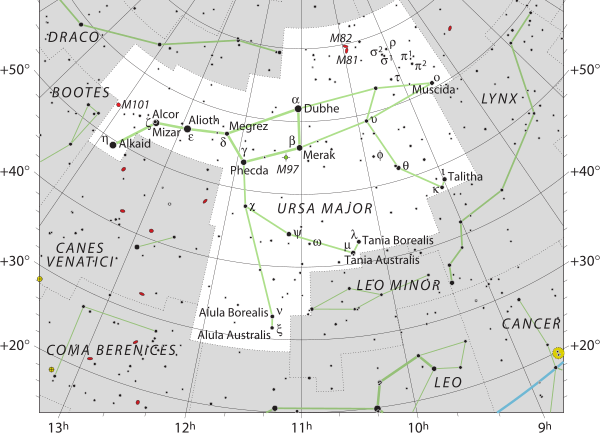Located in the northern sky, Ursa Major, also known as the Great Bear, is a constellation with an associated mythology that likely dates back into prehistory. The Latin name means “greater she-bear,” which refers to and contrasts with nearby Ursa Minor, the lesser bear. Ursa Major covers 1279.66 square degrees or 3.10% of the night sky, which makes it the third largest constellation.
Ursa Major was 1 of the 48 constellations that Ptolemy lists in the 2nd century. The asterism is the most famous feature of the constellation, which uses the 7 main stars and is known as the “Big Dipper” or “the Plough.” The Big Dipper’s stellar configuration mimics the shape of the “Little Dipper.” Ursa Major can be found on the flag of the US state of Alaska.
Ursa Major is visible throughout the year from most of the northern hemisphere, and appears circumpolar above the mid-northern latitudes.
| Applicable Information | |
| Visibility In Pacific Northwest | December to June |
| Best Times To View | April |
| Right Ascension | 10.67h |
| Declination | +55.38° |
| Area | 1280 square degrees |
| Main Stars | 7, 20 |
| Brightest Object | ε UMa |
| Meteor showers | Alpha Ursa Majorids, Leonids-Ursids |
| Messier objects | 7 |
| Neighboring Constellations | Draco, Camelopardalis, Lynx, Leo Minor, Leo, Coma Berenices, Canes Venatici, Boötes |
Mythology
In Javanese, Ursa Major is known as “lintang jong,” which translates to “the jong constellation.”
The Iroquois interpreted Alioth, Mizar, and Alkaid as three hunters pursuing the Great Bear.
The Lakota people call the constellation Wičhákhiyuhapi, or “Great Bear.”
The Wampanoag people, otherwise known as Algonquian, referred to Ursa Major as “maske,” meaning “bear.”
The Wasco-Wishram Native Americans interpreted the constellation as 5 wolves and 2 bears that were left in the sky.
The constellation is one of the few stars groups mentioned by the Bible.
In China and Japan, the Big Dipper is called the “North Dipper,” and in South Korea, the constellation is referred to as “the seven stars of the north.”
In Shinto, the seven largest stars of Ursa Major belong to Amenominakanushi, the oldest and most powerful of all kami.
In Hinduism, Ursa Major is known as Saptarshi, where each of the stars represents 1 of the Saptarshis or Seven Sages.
In Roman mythology, Jupiter lusts after a young woman named Callisto, a nymph of Diana. Juno, Jupiter’s jealous wife, would transform Callisto into a bear so she no longer attracts Jupiter. Jupiter would turn Arcas into a bear too and put both into the sky, forming Ursa Major and Ursa Minor. Callisto is Ursa Major and her son, Arcas, is Ursa Minor.
Stars
Ursa Major contains seven Messier objects, which are Messier 40, Messier 81, Messier 82, Messier 97, Messier 101, Messier 108, and Messier 109. At this time, there are 13 stars with confirmed planets and 22 formally named stars.
The asterism “The Big Dipper” is made by the 7 brightest stars in the constellation, as it is known in the US. For those in the UK, the asterism is known as “the Plough.” 6 of the 7 stars that form this asterism are of the 2nd magnitude or higher and is one of the best known asterisms.
M81 is a spiral galaxy with a core made up of old stars, with arms filled with young stars and nebulae. The large size and brightness makes M81 a popular target for amateur astronomers, with binoculars and telescopes. Telescopes with apertures of 8 inches or larger are required for the observer to distinguish structures.
M82 is a galaxy that is interacting gravitationally with M81. M82 is a popular target for amateur astronomers that can be seen with binoculars and telescopes.
M97, also known as the Owl Nebula, is a planetary nebula that was discovered in 1781. Observing the Owl Nebula can be done in good conditions with a small telescope or binoculars. The distinctive features of M97 can be made out with a 10″ or larger telescope.
M101, also called the Pinwheel Galaxy, is a face-on spiral galaxy that has strong ultraviolet emissions. It is visible in both binoculars and telescopes, but not to the naked eye.
Messier 108 is a barred spiral galaxy that can best be seen in April. M108 can be seen with small telescopes as an elliptical streak of light with a brighter core, while telescopes 8 inches or larger will reveal more detail.
Messier 109 is a barred spiral galaxy, the outer spiral arms is quite faint and only the bright central bar and nucleus region show well to smaller telescopes. Messier 109 will require dark, clear skies and at least mid-sized aperture to begin seeing details.
The Hubble Deep Field is located to the northeast of the star δ Ursae Majoris.
Make sure to check out other articles on the site, including a brief introduction to constellations, other constellation articles, and more!

Be the first to comment on "Ursa Major"